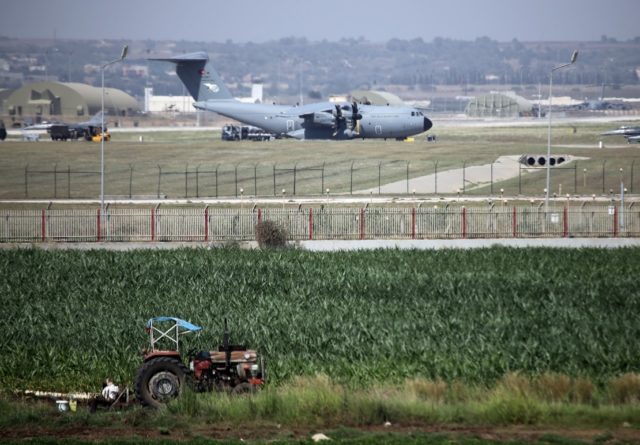
The United States runs its air operations against ISIS in Iraq from Incirlik Air Base in Turkey. The base, used by other NATO forces as well, is not American. It is Turkish, and the U.S. needs government permission to fly from there. Since the 15 July coup attempt in Ankara, U.S. forces at Incirlik are essentially hostages to the Turkish government. The Turkish base commander and his aides have been arrested; U.S. personnel are confined to base; outside power has been cut off; and while the U.S. has been permitted to resume operations over Iraq and Syria, it is working under adverse conditions, to say the least. Most worrisome, about 50 hydrogen bombs are stored by the U.S. at Incirlik, ostensibly on behalf of NATO. These bombs are “protected” by Turkish troops and to some degree their potential use is shared with the Turkish Air Force.
The deployment goes back more than 50 years, begun as an effort to counter the Soviet military buildup as an offset to quantitatively larger Soviet ground forces facing Europe. But by the mid-1980s the U.S. put more emphasis on “tactical” missiles, largely to counter the Soviet Union’s deployment of SS-20’s, a short to medium range missile with multiple, independently targeted warheads (MIRV) in the second and third versions of the SS-20. In 1987 the Intermediate and Short-range Missile Nuclear Treaty (INF) was signed and the Russians and the U.S. began removing their missiles. By 1991, all the missiles of concern on both sides were eliminated.
With the collapse of the Soviet Union and the expansion of NATO, one can ask why tactical nuclear weapons in NATO were retained as times and conditions have changed. The U.S. now finds itself escalating operations out of Incirlik as it increases the fight against ISIS, al Nusra, and al Qaeda. Turkey itself is increasingly authoritarian and increasingly involved in the wars in Syria and Iraq as well as fighting Kurdish separatists. But only late in 2015 did Incirlik see the beginning of security upgrades for its nuclear stockpile.
Why didn’t we just take them out?
Incirlik nuclear weapons are unlikely to be used against Russia. The missiles need to be delivered by aircraft that can penetrate Russian air defenses — which have been steadily improved. Newer Russian systems such as the S-300, S-400, and the soon to come S-500 raise a host of new challenges. As U.S. Air Force Chief of Staff Mark Welch and LTG Herbert “Hawk” Carlisle, Chief of the Air Combat Command, have testified, there are ten or more — and there will be more — “integrated air defense systems in the world that you would have a difficult time operating in or around in aircraft.” They didn’t specifically mention Russia, but it can be assumed they meant U.S. Air Force conventional bombers would have a hard time with Russia’s air defenses and newest radars. In a real conflict, it can be assumed that more likely than a U.S. strike on Russian nuclear weapons depots is a Russian strike on nuclear storage depots like Incirlik.
Furthermore, the old Soviet threat scenario no longer exists. While Russia is aggressive, especially around its perimeter, today’s problem is qualitatively different from that posed by an organized Soviet attack on the Fulda Gap. The Russian army and navy are no longer of the size or capability to launch a real challenge to NATO — even in NATO’s current less-than-optimal state. While it could technically pick off some weak sisters like Estonia or Lithuania, such aggression could precipitate painful Western countermeasures. NATO could challenge Russia’s Baltic and Black Sea fleets; it could attack Crimea; it could launch cross-border attacks to take out Russian military threats to NATO members. NATO could do a number of things, or nothing, but this is not an environment in which nuclear weapons would be useful.
It should be noted that the weapons kept in Turkey are each about ten times more powerful than the atomic bombs that destroyed Hiroshima and Nagasaki. They should not be considered “tactical” at all. These are WMD — that is, weapons of mass destruction. Keeping them in harm’s way is an act of political irresponsibility.
And then there is the problem of Turkey. Increasingly radicalized, if Turkey were to acquire the weapons for itself — say by expelling U.S. and NATO forces from Incirlik — it would not only have the weapons, but the means to deliver them. Turkey has F-16s and nuclear-capable F-4 Phantom jets. A nuclear Turkey would become a significant threat in the Middle East in a multitude of directions (i.e., against Greece/Cyprus, against Israel, against Russia, against Iran). It would absolutely cause Iran to mount nukes on missiles (which it could quickly acquire from North Korea if not locally produced). A nuclear Turkey is immense threat to involve NATO in a conflict with no clear or positive outcome.
Finally, there is always the possibility of terrorists getting nuclear bombs. Under current political conditions, with the Turkish general staff and military decimated, the time is ripe for an external attack on Incirlik. The acquisition of a potentially usable nuclear weapon by terrorists is the worst nightmare of all.
It would be optimal to ship the weapons out of Turkey, but if that is not possible, there is a lesson from history. After the Turkish invasion of Cyprus, the U.S. physically disabled the nuclear weapons under its control. In any case, a rescue team should be positioned in the area, ready to intervene if necessary. For the U.S. to continue operating in a business-as-usual mode, but under hostage-like conditions, is extraordinarily risky.

